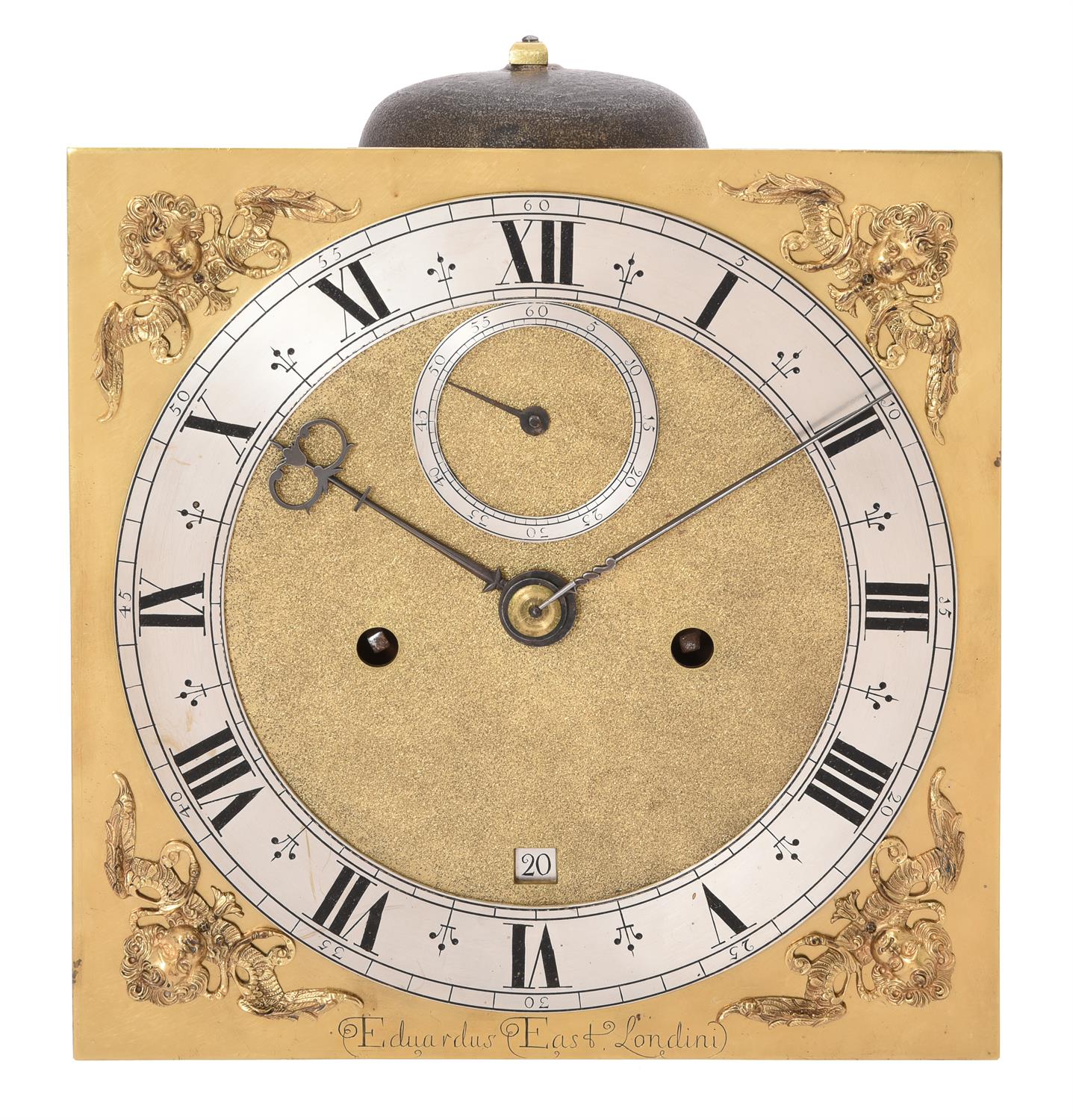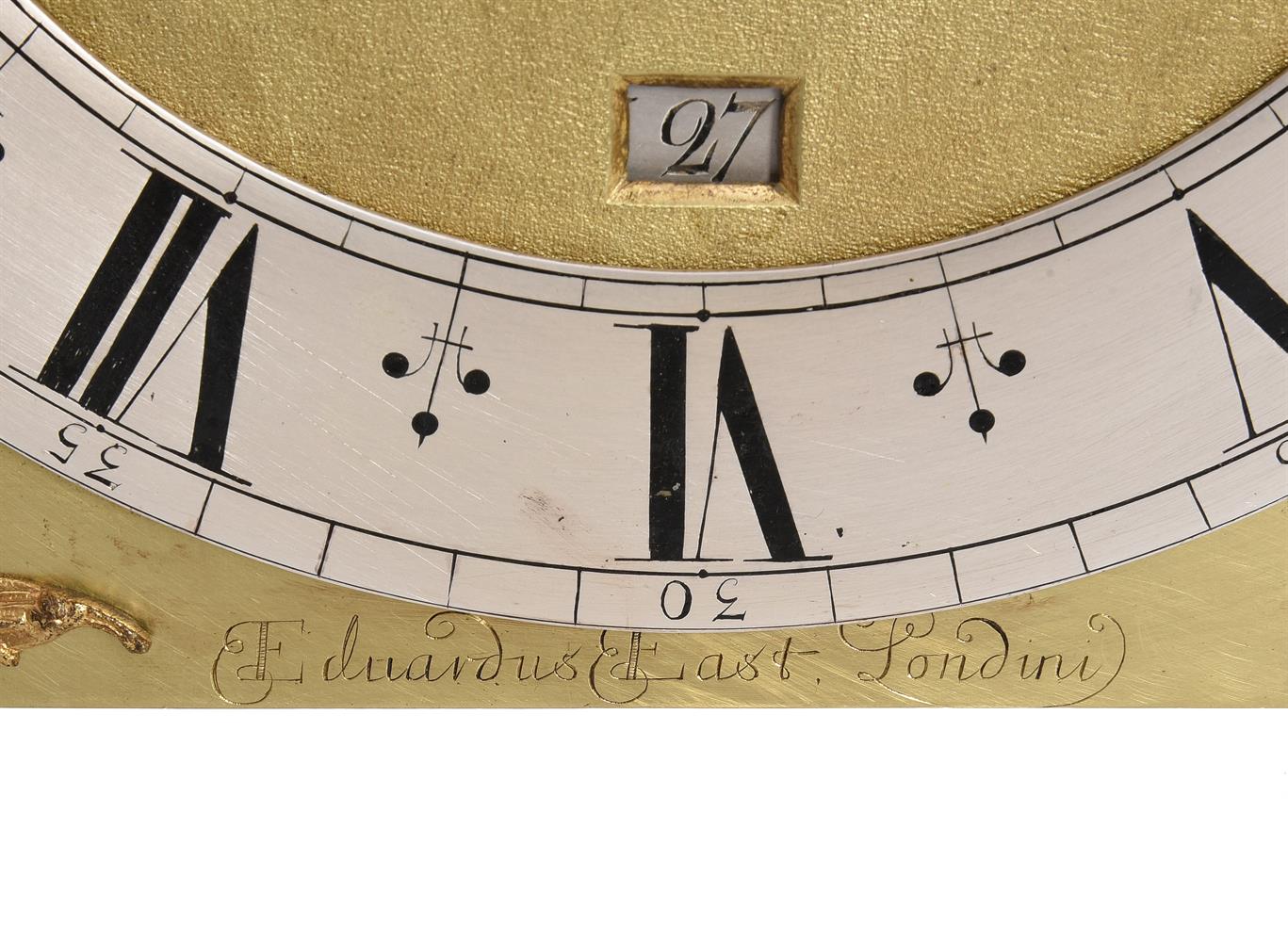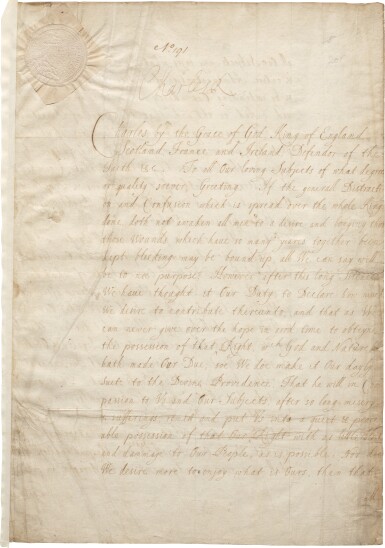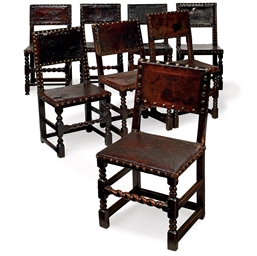A Charles II eight-day striking longcase clock movement By Joseph Knibb London, circa 1680The 9... A Charles II eight-day striking longcase clock movement By Joseph Knibb London, circa 1680 The 9 1/2in. square gilt dial, with line-engraved edge, signed at the base Joseph Knibb Londini Fecit, with winged cherub mask spandrels, narrow silvered chapter ring, blued steel hands (Oxford hour hand), matted centre with calendar aperture, the twin train movement with six latched finely turned columns, bolt-and-shutter maintaining power, fine steel work, anchor escapement with bridgecock to the backplate for the pallets, and external countwheel strike (dial re-gilded) Joseph Knibb a celebrated member of the cadre from the Golden Age of Clockmaking, was born in 1640 at Claydon, Oxfordshire. He was apprenticed to his cousin Samuel in Newport Pagnell circa 1655. In 1662 Samuel moved to London and Joseph moved to Oxford where he set up premises in St. Clement's, outside the city. Around 1665/6 he moved to Holywell Street, within the city bounds. Once his business was inside the city walls, Joseph faced a level of opposition to becoming a Freeman of the City, finally granted to him in 1668. In 1670 he moved to London, most likely to take over his cousin Samuel's workshop, following his death. Admitted to the Worshipful Company of Clockmakers, he set up business at the Dyal, near Serjeant's Inn in Fleet Street. He was elected as a Steward of the Clockmakers' Company in 1684 and Assistant in 1689. He retired in 1697 and went to live at his estate in Hanslope, Buckinghamshire, where he died in 1711. The simple elegance of Knibb's dial here recalls the celebrated Admiral Byng Knibb, which dates to circa 1672-75. The only dial variance is the addition of a seconds ring on the Byng. COMPARATIVE LITERATURE: Ronald Lee, The Knibb Family Clockmakers, Byfleet, 1964, p. 26, 104 & 136 Dawson, Drover & Parkes, Early English Clocks, 1982, p. 196-7 & 256; pl. 264, 346 R. Garnier & L. Hollis, Innovation & Collaboration, 2018, p. 250-1
A Charles II eight-day striking longcase clock movement By Joseph Knibb London, circa 1680The 9... A Charles II eight-day striking longcase clock movement By Joseph Knibb London, circa 1680 The 9 1/2in. square gilt dial, with line-engraved edge, signed at the base Joseph Knibb Londini Fecit, with winged cherub mask spandrels, narrow silvered chapter ring, blued steel hands (Oxford hour hand), matted centre with calendar aperture, the twin train movement with six latched finely turned columns, bolt-and-shutter maintaining power, fine steel work, anchor escapement with bridgecock to the backplate for the pallets, and external countwheel strike (dial re-gilded) Joseph Knibb a celebrated member of the cadre from the Golden Age of Clockmaking, was born in 1640 at Claydon, Oxfordshire. He was apprenticed to his cousin Samuel in Newport Pagnell circa 1655. In 1662 Samuel moved to London and Joseph moved to Oxford where he set up premises in St. Clement's, outside the city. Around 1665/6 he moved to Holywell Street, within the city bounds. Once his business was inside the city walls, Joseph faced a level of opposition to becoming a Freeman of the City, finally granted to him in 1668. In 1670 he moved to London, most likely to take over his cousin Samuel's workshop, following his death. Admitted to the Worshipful Company of Clockmakers, he set up business at the Dyal, near Serjeant's Inn in Fleet Street. He was elected as a Steward of the Clockmakers' Company in 1684 and Assistant in 1689. He retired in 1697 and went to live at his estate in Hanslope, Buckinghamshire, where he died in 1711. The simple elegance of Knibb's dial here recalls the celebrated Admiral Byng Knibb, which dates to circa 1672-75. The only dial variance is the addition of a seconds ring on the Byng. COMPARATIVE LITERATURE: Ronald Lee, The Knibb Family Clockmakers, Byfleet, 1964, p. 26, 104 & 136 Dawson, Drover & Parkes, Early English Clocks, 1982, p. 196-7 & 256; pl. 264, 346 R. Garnier & L. Hollis, Innovation & Collaboration, 2018, p. 250-1















Testen Sie LotSearch und seine Premium-Features 7 Tage - ohne Kosten!
Lassen Sie sich automatisch über neue Objekte in kommenden Auktionen benachrichtigen.
Suchauftrag anlegen